Patent Landscape of Composting Technology: A Review
Abstract
:1. Introduction
2. General Processes of Composting
2.1. Anaerobic Composting
2.2. Aerobic Composting
3. Important Parameters in the Composting Process
3.1. Carbon to Nitrogen (C:N) Ratio
3.2. Particle Size
3.3. Temperature
3.4. Oxygen Concentration and Moisture Content
3.5. pH Value
3.6. Summary of the Optimum Values for the Composting Parameters
4. Different Composting Technologies
4.1. Manual Technology
4.1.1. Windrow Composting
4.1.2. Passively Aerated Windrow Composting
4.1.3. Bin Composting
4.1.4. In-Vessel Composting
4.1.5. Vermicomposting
4.2. Automatic Composting Technology
4.2.1. Forced Aerated Windrow Composting
4.2.2. Automatic Turning In-Vessel Composting
4.2.3. Electrical Home Composter
4.2.4. Comparative Summaries of the Manual and Automatic Composting Methods
5. Methodology of Review
5.1. Patent Review Process
5.2. Patent Analysis
5.3. Detailed Review of Selected Patents
6. Results and Discussions
6.1. Patent Landscape Overview
6.2. Technology Updates
6.2.1. Technological Updates on Manual Composting Technology
6.2.2. Technological Updates on Partially Automated Composting Technology
6.2.3. Technological Updates on Fully Automated Composting Technology
7. Conclusions
Author Contributions
Funding
Institutional Review Board Statement
Informed Consent Statement
Conflicts of Interest
Appendix A
| Number in Figure | Description |
|---|---|
| 1 | Composting device |
| 2 | Receptacle |
| 3 | Rigid side walls of composting container |
| 4 | Base of composting container |
| 5 | Opening of composting container |
| 6 | Hinged closure of composting container |
| 7 | Internal space of composting container |
| 8 | Wheels |
| 9 | Plate |
| 10 | Central aperture of plate |
| 11 | Side supports of plate |
| 12 | Fluid collection chamber |
| 13 | Aerator |
| 14 | Internal air chamber |
| 15 | Lower end internal air chamber |
| 16 | Upper end internal air chamber |
| 17 | Multitude of apertures of aerator |
| 18 | Air supply tube |
| 19 | Air inlet on side wall |
| 20 | Aperture of air supply |
| 21 | Fluid outlet |
| 22 | Clear plastic tube |
| 37 | A lining bag for draining apertures |
| Number in Figure | Description |
|---|---|
| 10 | Composter |
| 12 | Body of composter |
| 14 | Frame of the body |
| 16 | First support structure of frame |
| 18 | Second support structure of frame |
| 20 | Connector of frames |
| 22 | Brace of two frames |
| 30 | First side of body |
| 32 | Second side of body |
| 34 | Third side of body |
| 36 | Inwardly curved portion of body |
| 38 | First outwardly curved portion of body |
| 40 | First inwardly extending portions of body |
| 42 | Second outwardly curved portion of body |
| 44 | Distance for separation |
| 46 | Front portion of body |
| 50 | Center section of front portion |
| 54 | Outwardly extending portion |
| 56 | Second inwardly extending portions of body |
| 58 | Lid |
| 62 | Hinges connected to body |
| 64 | Latches secured onto lid |
| 78 | Fasteners connected to front portion |
| Number in Figure | Description |
|---|---|
| 1 | Water pump |
| 2 | Liquid collecting area |
| 3 | Filtering bed fermentation chamber |
| 4 | Outlet of fermenting tank |
| 5 | Motor |
| 6 | Air outlet |
| 7 | Water inlet |
| 8 | Blower |
| 9 | Gas pipe |
| 10 | Sieve plate |
| 11 | Water outlet |
| 12 | Liquid outlet pipe |
| 13 | Shaft |
| 14 | Stirring blades |
| 15 | Liquid inlet |
| 22 | Water pump |
| Number in Figure | Description |
|---|---|
| 12 | Flat insulated panels |
| 30 | Longitudinal rigid structural elements |
| 35 | Structural hoops |
| 40 | Rollers |
| 41 | Drive shafts |
| 43 | Electric motor |
| 100 | Composting container |
| Number in Figure | Description |
|---|---|
| 1 | Processing box body |
| 2 | Driving gear |
| 3 | Buffer piece |
| 4 | Drying box |
| 5 | Guide plate |
| 6 | Crushing box |
| 8 | Second motor |
| 9 | Crushing teeth |
| 10 | Crushing roller |
| 11 | First sieve plate |
| 12 | Brake cylinder |
| 13 | Granulating box |
| 14 | Granulating plate |
| 15 | Second sieve plate |
| 16 | Transmission plate |
| 17 | Transmission gear |
| 18 | Transmission shaft |
| 19 | Transmission wheel |
| 20 | Fan blade |
| 22 | Mounting groove |
| Number in Figure | Description |
|---|---|
| 1 | Input chamber |
| 11 | Input port |
| 12 | Blades |
| 13 | Second nozzle |
| 14 | Dryer |
| 15 | Bucket cover |
| 16 | Induction control member |
| 161 | Infrared sensor |
| 162 | Controller |
| 163 | Driving part |
| 17 | Vane motor |
| 18 | Vane shaft |
| 19 | Early warning sensor |
| 2 | Fermentation chamber |
| 21 | Preliminary fermentation sub-chamber |
| 22 | Full fermentation sub-chamber |
| 23 | First nozzle |
| 24 | One-way pressure relief valve |
| 25 | Liquid storage tank |
| 251 | Liquid level sensor |
| 26 | Delivery pump |
| 27 | Thermostat |
| 28 | Heating element |
| 3 | Storage room |
| 31 | Drop port |
| 32 | Fertilizer level sensor |
| 4 | Solid-liquid separation component |
| 41 | Filter screen |
| 42 | Liquid container |
| 43 | Conduit |
| 431 | Nested piece |
| 44 | Collection bottle |
| 51 | First opening |
| 52 | Second opening |
| 53 | Third opening |
| 54 | Fourth opening |
| 6 | Opening and closing parts |
| 61 | Left baffle |
| 62 | Right baffle |
| 7 | Sealing ring |
| 8 | Shell |
| Number in Figure | Description |
|---|---|
| 1 | Solar power generation device |
| 2 | Battery |
| 3 | Upper end of barrel cover |
| 4 | Double-shaft pulverizer |
| 5 | Stainless steel |
| 6 | Sponge |
| 7 | Plexiglass |
| 8 | Oxygen concentration detector |
| 9 | Cylindrical ventilator |
| 10 | Three-layer inclined paddle stirrer |
| 11 | Air outlets |
| 12 | Electric heating wires |
| 13 | Insulating and thermally conductive silica gel |
| 14 | Compost outlet |
| 15 | Barrel |
| 16 | Flow fan intake port |
| 17 | Axial fan |
| 18 | Natural ventilation port |
| 19 | Ranging infrared sensor |
| 20 | Fungus chaff barrel |
| 21 | Funnel-shaped baffle |
| 22 | Pyroelectric infrared sensor |
| 23 | LED display screen |
| Number in Figure | Description |
|---|---|
| 1 | Sealing cover |
| 2 | Feeding port |
| 3 | Crushing chamber |
| 4 | Crushing gear |
| 5 | Operation chamber |
| 6 | Motor |
| 7 | Rotating shaft |
| 8 | Rotating rod |
| 9 | Stirring blade |
| 10 | Oxygen delivery pipe |
| 11 | Valve |
| 12 | Ozone tank |
| 13 | Fixed rope |
| 14 | Delivery port |
| 15 | Fan |
| 16 | Air inlet |
| 17 | Support rod |
| 18 | Partition |
| 19 | Base |
| 20 | Cross bar |
| 21 | Placement slot |
| 22 | Collection box |
| 23 | Sight glass |
| 24 | Drawer |
References
- Tiseo, I. Global Municipal Solid Waste Generation Projection 2016–2050. 2018. Available online: https://www.statista.com/statistics/916625/global-generation-of-municipal-solid-waste-forecast/ (accessed on 24 June 2021).
- Abdel-Shafy, H.I.; Mansour, M.S.M. Solid waste issue: Sources, composition, disposal, recycling, and valorization. Egypt. J. Pet. 2018, 27, 1275–1290. [Google Scholar] [CrossRef]
- Ncube, L.K.; Ude, A.U.; Ogunmuyiwa, E.N.; Zulkifli, R.; Beas, I.N. An overview of plasticwaste generation and management in food packaging industries. Recycling 2021, 6, 12. [Google Scholar] [CrossRef]
- Department of Environment, Park, and Recreation Brunei Darussalam. No Time to Waste. Borneo Bulletin. 2021. Available online: https://borneobulletin.com.bn/no-time-to-waste/ (accessed on 26 July 2021).
- Ferronato, N.; Torretta, V. Waste mismanagement in developing countries: A review of global issues. Int. J. Environ. Res. Public Health 2019, 16, 1060. [Google Scholar] [CrossRef] [PubMed] [Green Version]
- ISWA. Working Together towards a Cleaner, Healthier Planet; International Solid Waste Association Annual Review; International Solid Waste Association: Vienna, Austria, 2017; Volume 1, pp. 1–17. [Google Scholar]
- Quina, M.J.; Bordado, J.C.M.; Quinta-Ferrerira, R.M. Air Pollution Control of Municipal Solid Waste Incinerators; IntechOpen: Rijeka, Croatia, 2011; pp. 1–30. [Google Scholar]
- Azis, F.A.; Suhaimi, H.; Abas, E. Waste Classification using Convolutional Neural Network. In ACM International Conference Proceeding Series; Association of Computing Machinery: New York, NY, USA, 2020; pp. 9–13. [Google Scholar]
- Popp, A. The world’s growing municipal solid waste: Trends and impacts. Environ. Res. Lett. 2020, 15, 074021. [Google Scholar]
- Turner, D.A.; Williams, I.D.; Kemp, S. Greenhouse gas emission factors for recycling of source-segregated waste materials. Resour. Conserv. Recycl. 2015, 105, 186–197. [Google Scholar] [CrossRef] [Green Version]
- Kaza, S.; Yao, L.; Bhada-Tata, P.; Van Woerden, F. A Global Snapshot of Solid Waste Management to 2050; World Bank Publications: Washington, DC, USA, 2020. [Google Scholar]
- Debruyn, J.; Hilborn, D. Anaerobic Digestion Basics. Small 2007, 2007, 1–6. [Google Scholar]
- Cecchi, F.; Cavinato, C. Anaerobic digestion of bio-waste: A mini-review focusing on territorial and environmental aspects. Waste Manag. Res. 2015, 33, 429–438. [Google Scholar] [CrossRef]
- Lin, L.; Xu, F.; Ge, X.; Li, Y. Biological treatment of organic materials for energy and nutrients production—Anaerobic digestion and composting. Adv. Bioenergy 2019, 4, 121–181. [Google Scholar] [CrossRef]
- Meegoda, J.N.; Li, B.; Patel, K.; Wang, L.B. A review of the processes, parameters, and optimization of anaerobic digestion. Int. J. Environ. Res. Public Health 2018, 15, 2224. [Google Scholar] [CrossRef] [Green Version]
- Ayilara, M.S.; Olanrewaju, O.S.; Babalola, O.O.; Odeyemi, O. Waste management through composting: Challenges and potentials. Sustainability 2020, 12, 4456. [Google Scholar] [CrossRef]
- Li, Z.; Huang, G.; Yu, H.; Zhou, Y.; Huang, W. Critical factors and their effects on product maturity in food waste composting. Environ. Monit. Assess. 2015, 187, 217. [Google Scholar] [CrossRef] [PubMed]
- Neugebauer, M.; Sołowiej, P.; Piechocki, J.; Czekała, W.; Janczak, D. The influence of the c: N ratio on the composting rate. Int. J. Smart Grid Clean Energy 2017, 6, 54–60. [Google Scholar] [CrossRef] [Green Version]
- Chen, L.M.; de Haro Marti, M.; Moore, A.; Falen, C. Dairy Compost Production and Use in Idaho: The Composting Process; University of Idaho: Moscow, Russia, 2011; pp. 1–5. [Google Scholar]
- Palaniveloo, K.; Amran, M.A.; Norhashim, N.A.; Mohamad-Fauzi, N.; Peng-Hui, F.; Hui-Wen, L.; Kai-Lin, Y.; Jiale, L.; Chian-Yee, M.G.; Jing-Yi, L.; et al. Food waste composting and microbial community structure profiling. Processes 2020, 8, 723. [Google Scholar] [CrossRef]
- Al-Rumaihi, A.; McKay, G.; Mackey, H.R.; Al-Ansari, T. Environmental impact assessment of food waste management using two composting techniques. Sustainability 2020, 12, 1595. [Google Scholar] [CrossRef] [Green Version]
- Meena, A.L.; Karwal, M.; Kj, R.; Narwal, E. Aerobic composting versus Anaerobic composting: Comparison and differences. Food Sci. Rep. 2021, 2, 23–26. [Google Scholar]
- Sunar, N.M.; Stentiford, E.I.; Stewart, D.I.; Fletcher, L.A. The Process and Pathogen Behavior in Composting: A Review. arXiv 2014, arXiv:1404.5210. [Google Scholar]
- Vázquez, M.A.; Plana, R.; Pérez, C.; Soto, M. Development of technologies for local composting of food waste from universities. Int. J. Environ. Res. Public Health 2020, 17, 3153. [Google Scholar] [CrossRef]
- Chang, H.Q.; Zhu, X.H.; Jie, W.U.; Guo, D.Y.; Zhang, L.H.; Yao, F. Dynamics of microbial diversity during the composting of agricultural straw. J. Integr. Agric. 2021, 20, 1121–1136. [Google Scholar] [CrossRef]
- Hubbe, M.A. Lignocellulose Biodegradation in Composting. In Composting for Sustainable Agriculture; Springer: Cham, Switzerland, 2014; pp. 43–66. [Google Scholar]
- Żukowska, G.; Mazurkiewicz, J.; Myszura, M.; Czekała, W. Heat energy and gas emissions during composting of sewage sludge. Energies 2019, 12, 4782. [Google Scholar] [CrossRef] [Green Version]
- Sokolova, V.; Krusir, G.; Sagdeeva, O.; Gnizdovskyi, O.; Malovanyy, M. Study of the Conditions for Accelerating the Composting Process when Adding Microbial Communities. J. Ecol. Eng. 2021, 22, 11–17. [Google Scholar] [CrossRef]
- EPA. Types of Composting and Understanding the Process. 2021. Available online: https://www.epa.gov/sustainable-management-food/types-composting-and-understanding-process (accessed on 12 August 2021).
- Meena, A.L.; Karwal, M.; Dutta, D.; Mishra, R.P. Composting: Phases and Factors Responsible for Efficient and Improved Composting. Agric. Food 2021, 3, 85–90. [Google Scholar]
- Cuyahoga County. Composting Guide; Solid Waste Management District: Garfield Heights, OH, USA, 2011; pp. 1–8. [Google Scholar]
- Farrell-Poe, K.; Engineer, E.E.; Koenig, R.; Specialist, E.S. Backyard Composting in Utah. 2011. Available online: https://extension.usu.edu/yardandgarden/research/backyard-composting-in-utah (accessed on 1 September 2021).
- Hashemi, B.; Sarker, S.; Lamb, J.J.; Lien, K.M. Yield improvements in anaerobic digestion of lignocellulosic feedstocks. J. Clean. Prod. 2021, 288, 125447. [Google Scholar] [CrossRef]
- Tratsch, M.V.M.; Ceretta, C.A.; da Silva, L.S.; Ferreira, P.A.A.; Brunetto, G. Composition and mineralization of organic compost derived from composting of fruit and vegetable waste. Rev. Ceres 2019, 66, 307–315. [Google Scholar] [CrossRef]
- Recipe, A.B. Compost Site Management Analytically Based Recipe Development; Vermont Agency of Natural Resources: Montpelier, VT, USA, 2015; pp. 1–10.
- United States Department of Agriculture. Composting. Environmental Engineering National Engineering Handbook; USDA: Washington, DC, USA, 2000; Volume 2000, pp. 1–7.
- Graves, R.E. Chapter 2 Composting. Environmental Engineering. In National Engineering Handbook; USDA: Washington, DC, USA, 2000; Volume 88, p. 637. [Google Scholar]
- Kumar, M.; Ou, Y.L.; Lin, J.G. Co-composting of green waste and food waste at low C/N ratio. Waste Manag. 2010, 30, 602–609. [Google Scholar] [CrossRef] [PubMed]
- Richard, T.L.; Veeken, A.H.M.; De Wilde, V.; Mhamelers, H.V. Air-filled porosity and permeability relationships during solid-state fermentation. Biotechnol. Prog. 2004, 20, 1372–1381. [Google Scholar] [CrossRef] [PubMed]
- Assandri, D.; Pampuro, N.; Zara, G.; Cavallo, E.; Budroni, M. Suitability of composting process for the disposal and valorization of brewer’s spent grain. Agriculture 2021, 11, 2. [Google Scholar] [CrossRef]
- Coker, C. Aerobic Composting and Anaerobic Digestion. Biocycle. 2014. Available online: https://www.biocycle.net/aerobic-composting-and-anaerobic-digestion/ (accessed on 29 July 2021).
- Jufri, R.F. The Effect of Environmental Factors on Microbial Growth. J. Lifesci. 2020, 1, 12–17. [Google Scholar] [CrossRef]
- Islam, M.S.; Kasim, S.; Alam, K.M.; Amin, A.M.; Geok, H.T.; Haque, M.A. Changes in Chemical Properties of Banana Pseudostem, Mushroom Media Waste, and Chicken Manure through the Co-Composting Process. Sustainability 2021, 13, 8458. [Google Scholar] [CrossRef]
- Puyuelo, B.; Gea, T.; Sánchez, A. A new control strategy for the composting process based on the oxygen uptake rate. Chem. Eng. J. 2010, 165, 161–169. [Google Scholar] [CrossRef] [Green Version]
- Wojcieszak, D.; Zaborowicz, M.; Przybył, J.; Boniecki, P.; Jędruś, A. Assessment of the content of dry matter and dry organic matter in compost with neural modelling methods. Agriculture 2021, 11, 307. [Google Scholar] [CrossRef]
- Goodell, B.; Winandy, J.E.; Morrell, J.J. Fungal degradation of wood: Emerging data, new insights and changing perceptions. Coatings 2020, 10, 1210. [Google Scholar] [CrossRef]
- Liu, T.; Ren, X.; Zhao, J.; Chen, H.; Wang, Q.; Awasthi, S.K.; Duan, Y.; Pandey, A.; Taherzadeh, M.J.; Awasthi, M.K.; et al. Sustainability analysis of large-scale food waste composting. In Current Developments in Biotechnology and Bioengineering; Elsevier: Amsterdam, The Netherlands, 2020; pp. 301–322. [Google Scholar] [CrossRef]
- Sayara, T.; Basheer-Salimia, R.; Hawamde, F.; Sánchez, A. Recycling of organic wastes through composting: Process performance and compost application in agriculture. Agronomy 2020, 10, 1838. [Google Scholar] [CrossRef]
- Jalalipour, H.; Jaafarzadeh, N.; Morscheck, G.; Narra, S.; Nelles, M. Potential of producing compost from source-separated municipal organic waste (A case study in Shiraz, Iran). Sustainability 2020, 12, 9704. [Google Scholar] [CrossRef]
- Arslan, E.I.; Ünlü, A.; Topal, M. Determination of the Effect of Aeration Rate on Composting of Vegetable-Fruit Wastes. Clean—Soil Air Water 2011, 39, 1014–1021. [Google Scholar] [CrossRef]
- Di, Y.; Liu, J.; Liu, J.; Liu, S.; Yan, L. Characteristic analysis for odor gas emitted from food waste anaerobic fermentation in the pretreatment workshop. J. Air Waste Manag. Assoc. 2013, 63, 1173–1181. [Google Scholar] [CrossRef] [PubMed] [Green Version]
- St Martin, C.C.G.; Dorinvil, W.; Brathwaite, R.A.I.; Ramsubhag, A. Effects and relationships of compost type, aeration and brewing time on compost tea properties, efficacy against Pythium ultimum, phytotoxicity and potential as a nutrient amendment for seedling production. Biol. Agric. Hortic. 2012, 28, 185–205. [Google Scholar] [CrossRef] [Green Version]
- Vigneswaran, S.; Kandasamy, J.; Johir, M.A.H. Sustainable Operation of Composting in Solid Waste Management. Procedia Environ. Sci. 2016, 35, 408–415. [Google Scholar] [CrossRef]
- Veeken, A.; Wilde, V.; Hamelers, B. Microbiology Passively Aerated Composting of Straw-Rich Organic Pig Manure. Compost Sci. Util. 2002, 10, 2. [Google Scholar] [CrossRef]
- Lim, L.Y.; Bong, C.P.C.; Lee, C.T.; Klemeš, J.J.; Sarmidi, M.R.; Lim, J.S. Review on the current composting practices and the potential of improvement using two-stage composting. Chem. Eng. Trans. 2017, 61, 1051–1056. [Google Scholar]
- Karnchanawong, S.; Suriyanon, N. Household organic waste composting using bins with different types of passive aeration. Resour. Conserv. Recycl. 2011, 55, 548–553. [Google Scholar] [CrossRef]
- Arrigoni, J.P.; Paladino, G.; Garibaldi, L.A.; Laos, F. Inside the small-scale composting of kitchen and garden wastes: Thermal performance and stratification effect in vertical compost bins. Waste Manag. 2018, 76, 284–293. [Google Scholar] [CrossRef] [PubMed]
- Manyapu, V.; Shukla, S.; Kumar, S.; Rajendra, K. In-vessel composting: A rapid technology for conversion of biowaste into compost. Open Access Int. J. Sci. Eng. 2017, 2, 58–63. [Google Scholar]
- El Zein, A. Moisture Content and Thermal Balance During Composting of Fish, Banana Mulch & Municipal Solid Wastes. Eur. Sci. J. 2015, 11, 169–187. [Google Scholar]
- Ganti, S. Vermicomposting. Int. J. Waste Resour. 2018, 8, 8–11. [Google Scholar] [CrossRef]
- Kaur, T. Vermicomposting: An Effective Option for Recycling Organic Wastes. In Organic Agriculture; IntechOpen: Hampshire, UK, 2020; pp. 1–17. [Google Scholar]
- Munroe, G.; Scott, J.; Burlington, C.; Scotia, N.; Holsteins, K.; Pre, G. Manual of On-Farm Vermicomposting and Vermiculture Organic Agriculture Centre of Canada Acknowledgements EcoAction Program of Environment Canada and New Ground Vermicomposting, Halifax, Nova Scotia; Organic Agriculture Centre of Canada: Truro, NS, Canada, 2007; p. 56. Available online: https://www.eawag.ch/fileadmin/Domain1/Abteilungen/sandec/E-Learning/Moocs/Solid_Waste/W4/Manual_On_Farm_Vermicomposting_Vermiculture.pdf (accessed on 16 August 2021).
- Lalander, C.H.; Komakech, A.J.; Vinnerås, B. Vermicomposting as manure management strategy for urban small-holder animal farms—Kampala case study. Waste Manag. 2015, 39, 96–103. [Google Scholar] [CrossRef] [Green Version]
- Larney, F.J.; Olson, A.F. Windrow temperatures and chemical properties during active and passive aeration composting of beef cattle feedlot manure. Can. J. Soil Sci. 2006, 86, 783–797. [Google Scholar] [CrossRef]
- Zealand, C.N. Introduction to Composting Science and Management for Industry Training; UNSW: Sydney, Australia, 2007. [Google Scholar]
- Mishra, S.; Mishra, S.K.; Mishra, S.K.; Yadav, K.D. Energy Assessment of rotary drum and aerated in-vessel for composting of garden waste. Res. Sq. 2021, 1–16. [Google Scholar] [CrossRef]
- Fakharulrazi, A.N.; Yakub, F. Designing an Automated Composter for Food Waste Management with the Implementation of Internet of Things. J. Sustain. Nat. Resour. 2020, 1, 9–14. [Google Scholar] [CrossRef]
- Miller, S. Electric Composters: What Are They and How Do They Work? 2019. Available online: https://www.foodcycler.com/post/electric-composters-what-are-they-and-how-do-they-work (accessed on 24 August 2021).
- Vitamix. Vitamix® FoodCycler® FC-50. 2020. Available online: https://www.vitamix.com/us/en_us/shop/foodcycler-fc-50#specs (accessed on 7 September 2021).
- BeyondGREEN. beyondGREEN All-Electric Pet Waste and Organic Waste Composter. 2021. Available online: https://byndgrn.com/products/pet-waste-composter (accessed on 30 June 2021).
- Oklin. GG-02 Manual Handbook. 2017. Available online: https://www.papstar-storyteller.de/fileadmin/user_upload/GG02_-_User_Manual_Engl_.pdf (accessed on 20 September 2021).
- Gadget, M. Lomi Composter Review: Turn Food Waste to Compost with One Button. 2021. Available online: https://mrgadget.com.au/lomi-review-turn-waste-to-compost/ (accessed on 30 August 2021).
- Kalea. KALEA Biological Process. 2020. Available online: https://www.mykalea.de/faq (accessed on 16 September 2021).
- Machines, P.P. NatureMill Ultra Kitchen Composter. 2013. Available online: https://www.peoplepoweredmachines.com/naturemill/naturemill-ultra.htm (accessed on 29 July 2021).
- Elalami, M.; Baskoun, Y.; Zahra Beraich, F.; Arouch, M.; Taouzari, M.; Qanadli, S.D. Design and Test of the Smart Composter Controlled by Sensors. In Proceedings of the 2019 7th International Renewable and Sustainable Energy Conference, IRSEC 2019, Agadir, Morocco, 27–30 November 2019. [Google Scholar]
- Kucbel, M.; Raclavská, H.; Růžičková, J.; Švédová, B.; Sassmanová, V.; Drozdová, J.; Raclavský, K.; Juchelková, D. Properties of composts from household food waste produced in automatic composters. J. Environ. Manag. 2019, 236, 657–666. [Google Scholar] [CrossRef]
- Moher, D.; Liberati, A.; Tetzlaff, J.; Altman, D.G.; PRISMA Group. Preferred reporting items for systematic reviews and meta-analyses: The PRISMA statement. PLoS Med. 2009, 151, 264–269. [Google Scholar]
- Mahlia, T.M.I.; Syaheed, H.; Abas, A.E.P.; Kusumo, F.; Shamsuddin, A.H.; Ong, H.C.; Bilad, M.R. Organic rankine cycle (ORC) system applications for solar energy: Recent technological advances. Energies 2019, 12, 2930. [Google Scholar] [CrossRef] [Green Version]
- Mahlia, T.M.I.; Syazmi, Z.A.H.S.; Mofijur, M.; Abas, A.E.P.; Bilad, M.R.; Ong, H.C.; Silitonga, A.S. Patent landscape review on biodiesel production: Technology updates. Renew. Sustain. Energy Rev. 2020, 118, 109526. [Google Scholar] [CrossRef]
- Yu, G.; Ran, W.; Shen, Q. Compost Process and Organic Fertilizers Application in China. Organic Fertilizers—From Basic Concepts to Applied Outcomes; InTech: Nanjing, China, 2016; pp. 1–24. [Google Scholar]
- Joseph, M.M. Composting Device. CA2328680C, 20 November 2007. [Google Scholar]
- Kent, R.S.C. Composter. CA2671248C, 13 March 2012. [Google Scholar]
- Qu, X.-L.; Wang, X.-J.; Zhao, X.-F. A Kitchen Waste Compost Device and Composting Method. CN103449849B, 3 December 2014. [Google Scholar]
- Li, J.; Zhang, T.-Z.; Wang, S.-S.; Guo, J.-J.; Wang, S.; Guo, D.; Liu, J.-C. A Kitchen Garbage Composting Device. CN206872695U, 12 January 2018. [Google Scholar]
- Chen, S.-J. A Good for Fermentation Composting Barrel. CN210163350U, 20 March 2020. [Google Scholar]
- Yuan, Y.-Z. A Drum-Type Aerobic Composting Device for Household Kitchen Garbage. CN212051158U, 1 December 2020. [Google Scholar]
- Guo, C.-J.; Meng, Y. A Horizontal Composting Device. CN213977467U, 17 August 2021. [Google Scholar]
- Neal, W.H. Rotatable Aerating Composter. CA2436322C, 18 July 2006. [Google Scholar]
- Zhou, S.-Q.; Yuan, J.-P.; Yang, Z.-Q. An organic garbage alternate aerobic and anaerobic composting. CN204824645U, 2 December 2015. [Google Scholar]
- Qiao, W.; Zeng, G.-M.; Huang, G.-H.; Yuan, X.-Z. Integrated Anaerobic-Aerobic Compost Reaction Device. CN1206189C, 15 June 2005. [Google Scholar]
- Huang, B.-F. A Fast, Harmless Organic Waste Processing Method and System. CN108383556A, 10 August 2018. [Google Scholar]
- Young, M.-J. Compost Maker Using Food Waste. KR2019021983A, 6 March 2019. [Google Scholar]
- Chen, B.-Z.; Zhao, D.-L. A food Waste Processing Device Capable of Recycling Resources. CN112354616A, 12 February 2021. [Google Scholar]
- Bradlee, M. Aerated Composter and Waste Collection Bin. US20120021504A1, 26 January 2012. [Google Scholar]
- Li, B.; Dong, Z.-Y.; Chen, Y.-H.; Zhu, J.-L.; Cai, Z.-Q. Domestic Waste Compost Device. CN101983951B, 1 May 2013. [Google Scholar]
- Xu, J.-P.; Dong, J.; Xu, J.-Q. A kitchen Garbage Composting Device for Family and Composting Treatment Method. CN107021795A, 8 August 2017. [Google Scholar]
- Guo, C.; Suo, Y.; Wang, W. Aerobic Composting Device. CN205088151U, 16 March 2016. [Google Scholar]
- Norman, B. Apparatus, Methods and Systems for Food Waste Recycling. AU2021204513A1, 29 July 2021. [Google Scholar]
- Rudas, T. A method for Processing Organic Waste. CN1248792C, 5 April 2006. [Google Scholar]
- Sun, G.; Wang, X.; Liu, X.; Shao, Z. Composting Device Based on Spiral Stirring Structure. CN112960996A, 15 June 2021. [Google Scholar]
- Wu, H.; Shen, K. A household Kitchen Waste Composter. CN208649153U, 16 March 2019. [Google Scholar]
- Li, Y.; Zhang, X.; Xie, Y.; Chang, L. An Outdoor Kitchen Waste Compost Fermentation Barrel. CN209555095U, 29 October 2019. [Google Scholar]
- Venkatakrishnaiah, G.B.; Sameer, T.V.M. A Device for Converting Organic Waste into Organic Compost. IN201841044613A, 29 May 2020. [Google Scholar]
- Wang, M.; Yang, D.; Zhou, T.; Meng, H.; Zhang, M.; Zhu, L. A Household Kitchen Waste Processing Device. CN111187101A, 22 May 2020. [Google Scholar]
- Cohn, R.S. Composting Systems and Methods. US8129177B2, 6 March 2012. [Google Scholar]
- Wright, J. Small Scale Automated Composter. US6284528B1, 4 September 2001. [Google Scholar]
- Wang, Y. A New Type Household Garbage Composting Device with Deodorizing Function. CN212954904U, 13 April 2021. [Google Scholar]
- Ricardo, A.D.P. Anaerobic Digester for the Treatment of Organic Waste. EP2980203A1, 3 February 2016. [Google Scholar]
- Zhang, X. An Aerobic and Anaerobic Composting Organic Garbage. CN208346058U, 8 January 2019. [Google Scholar]





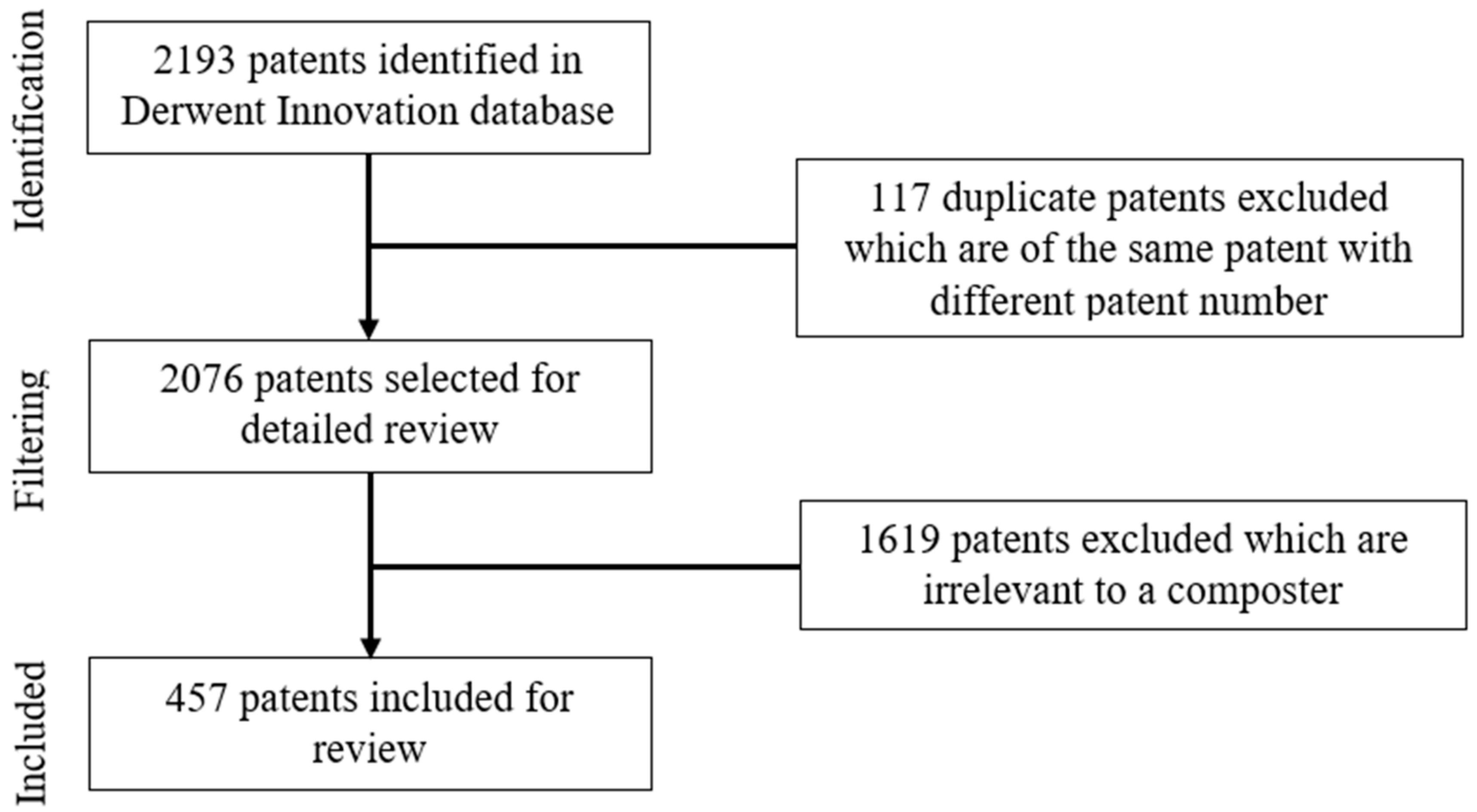

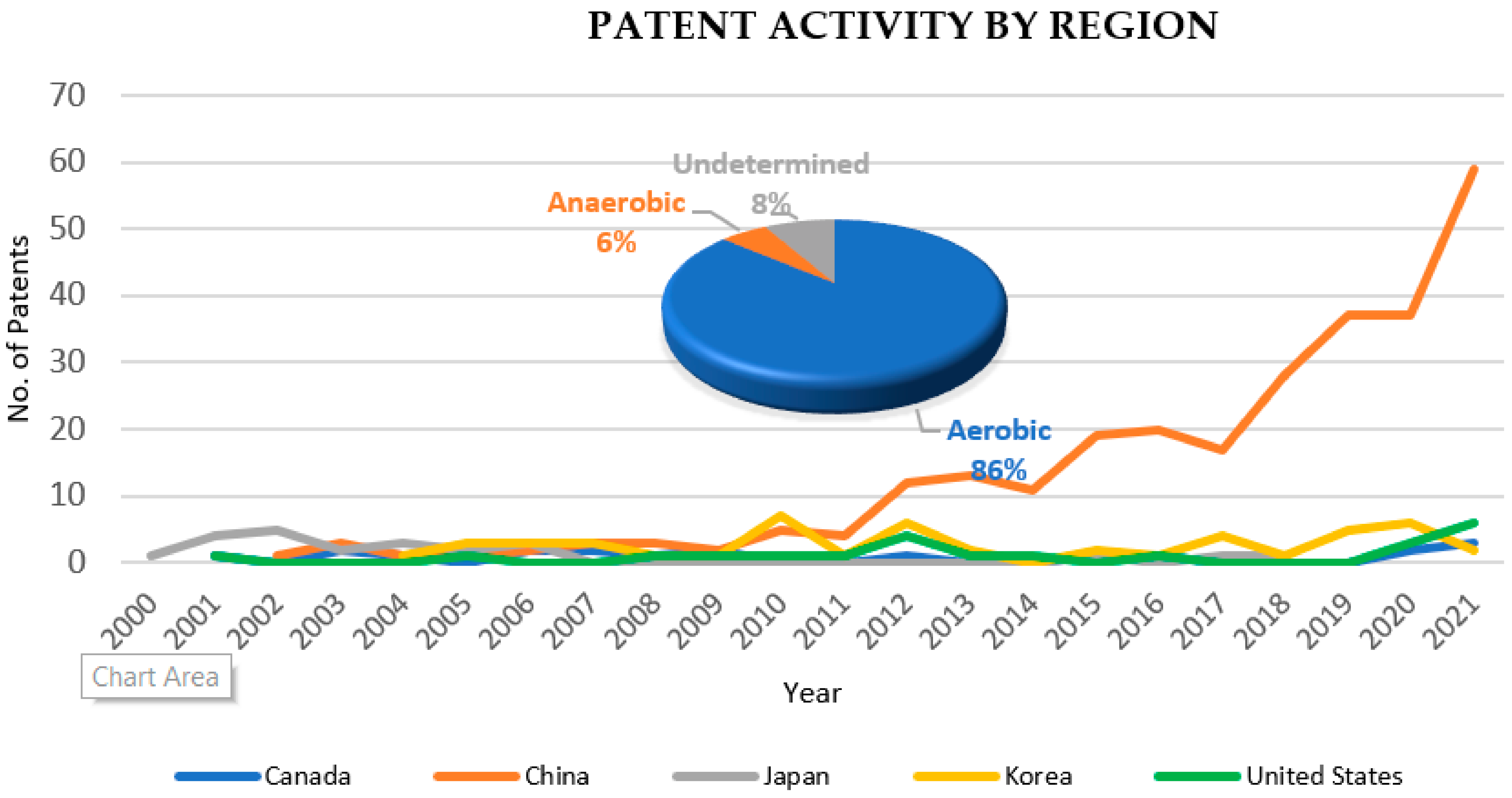
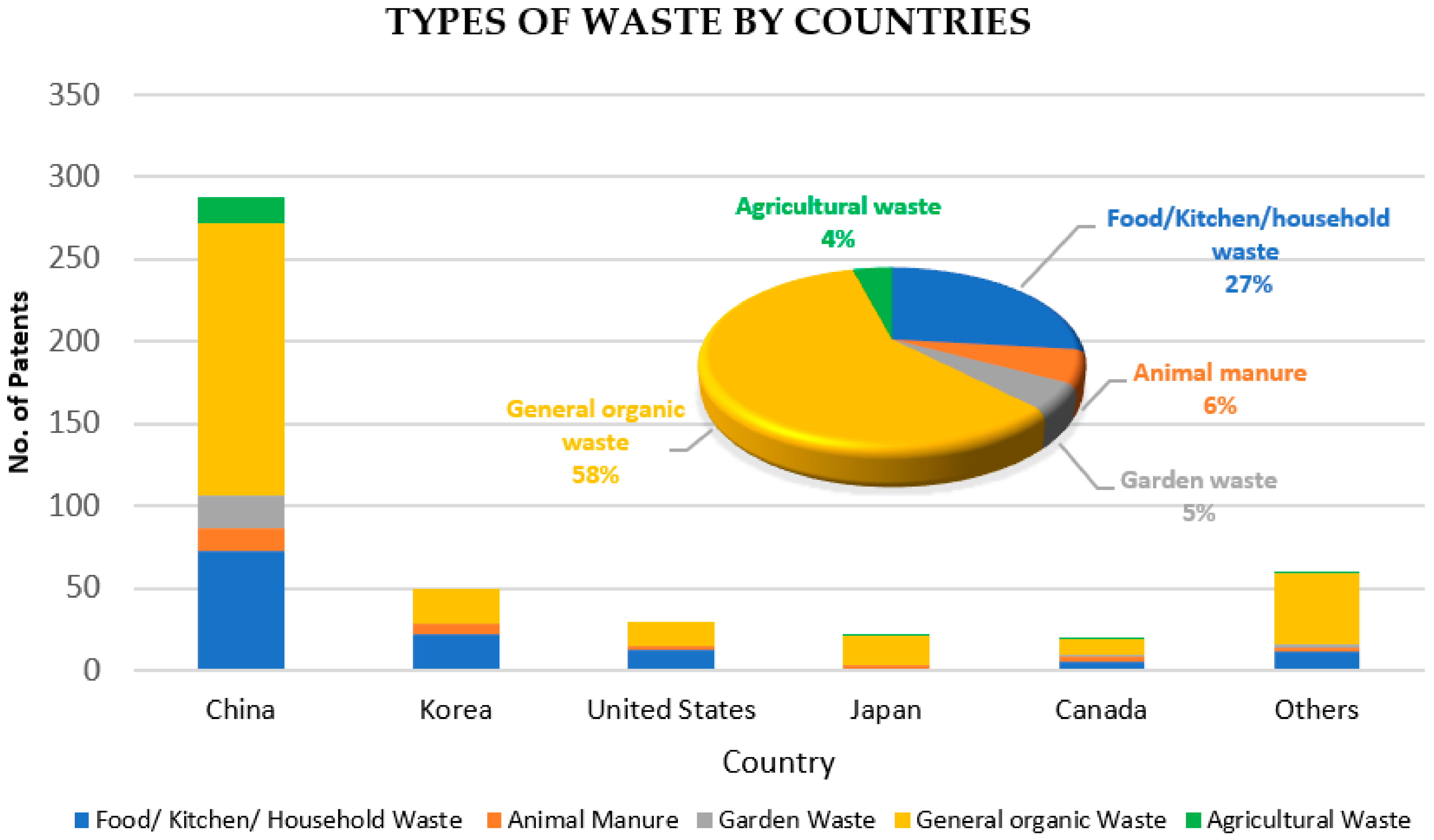

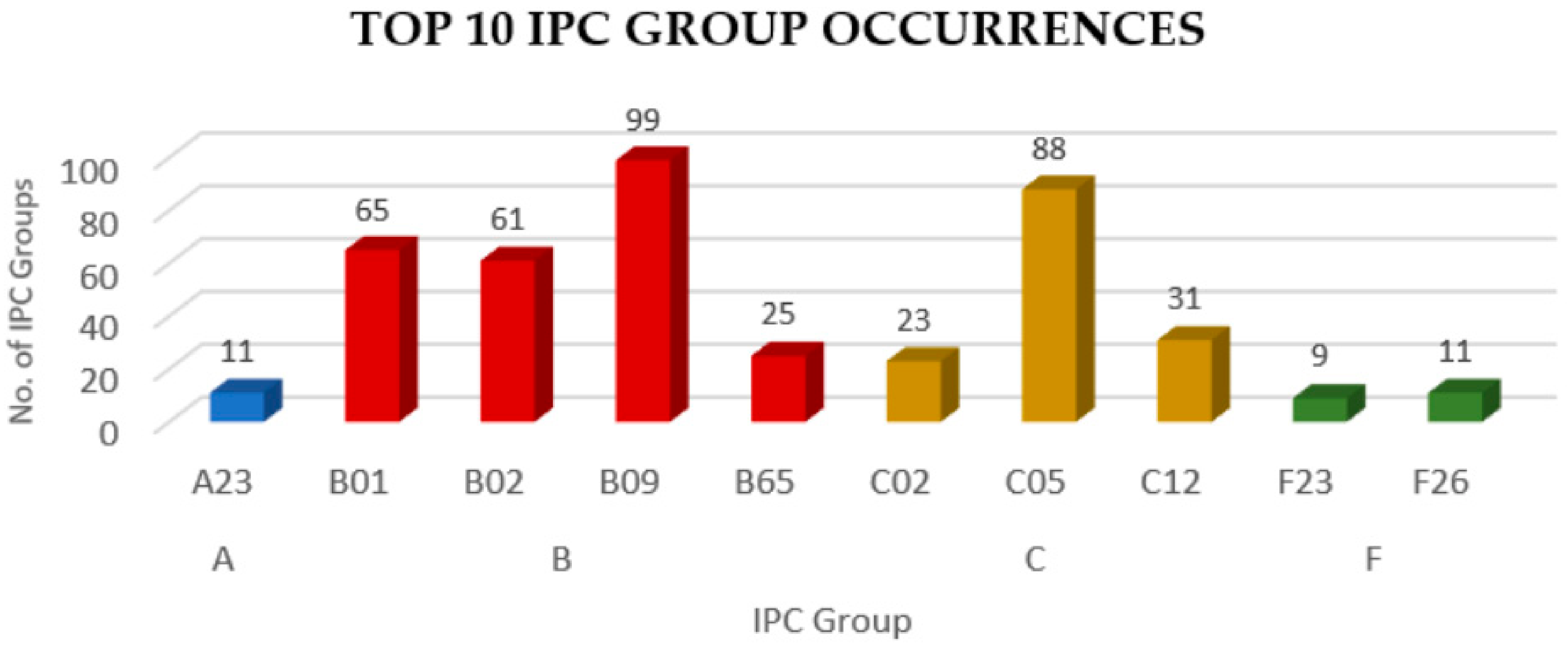

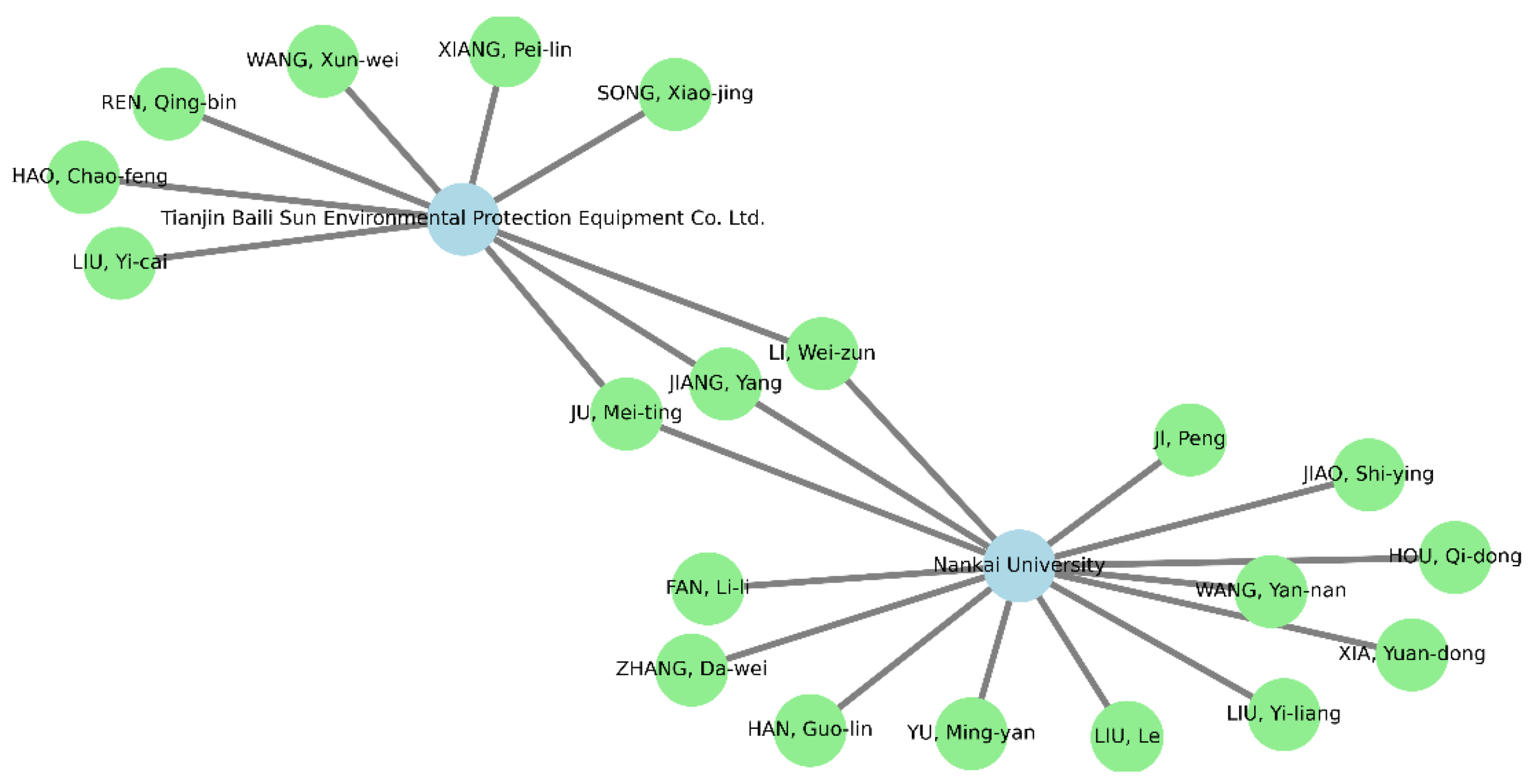
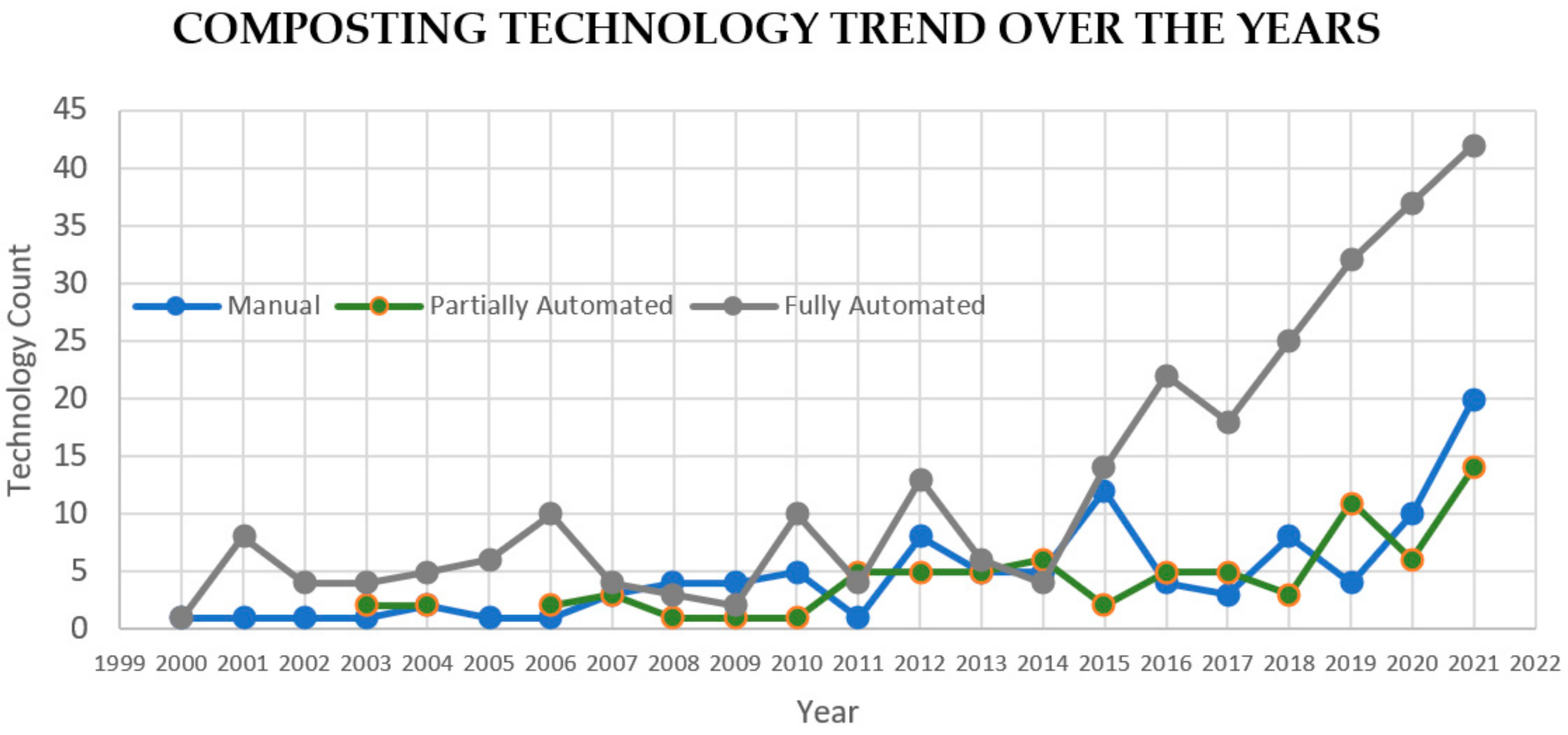
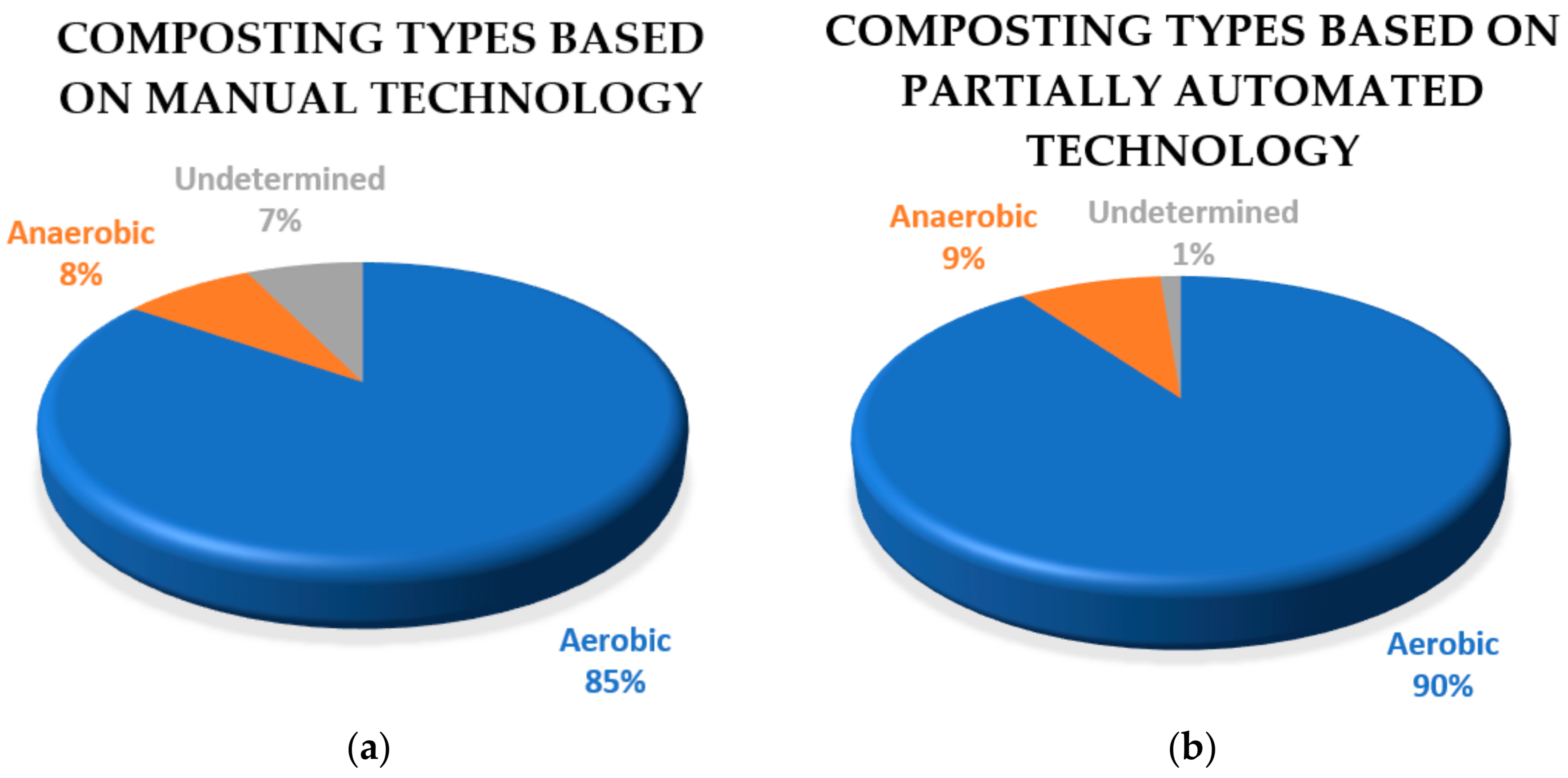
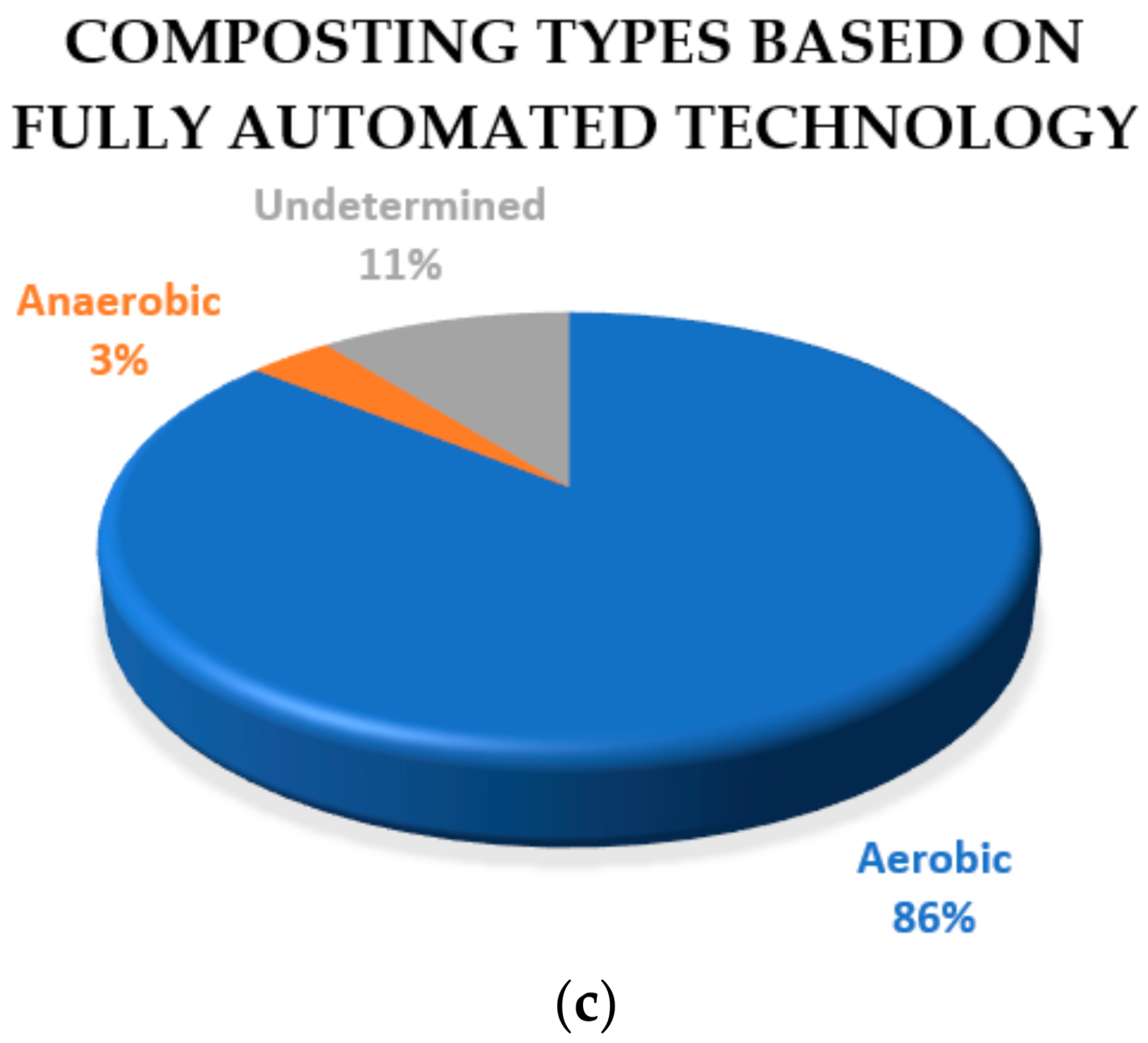
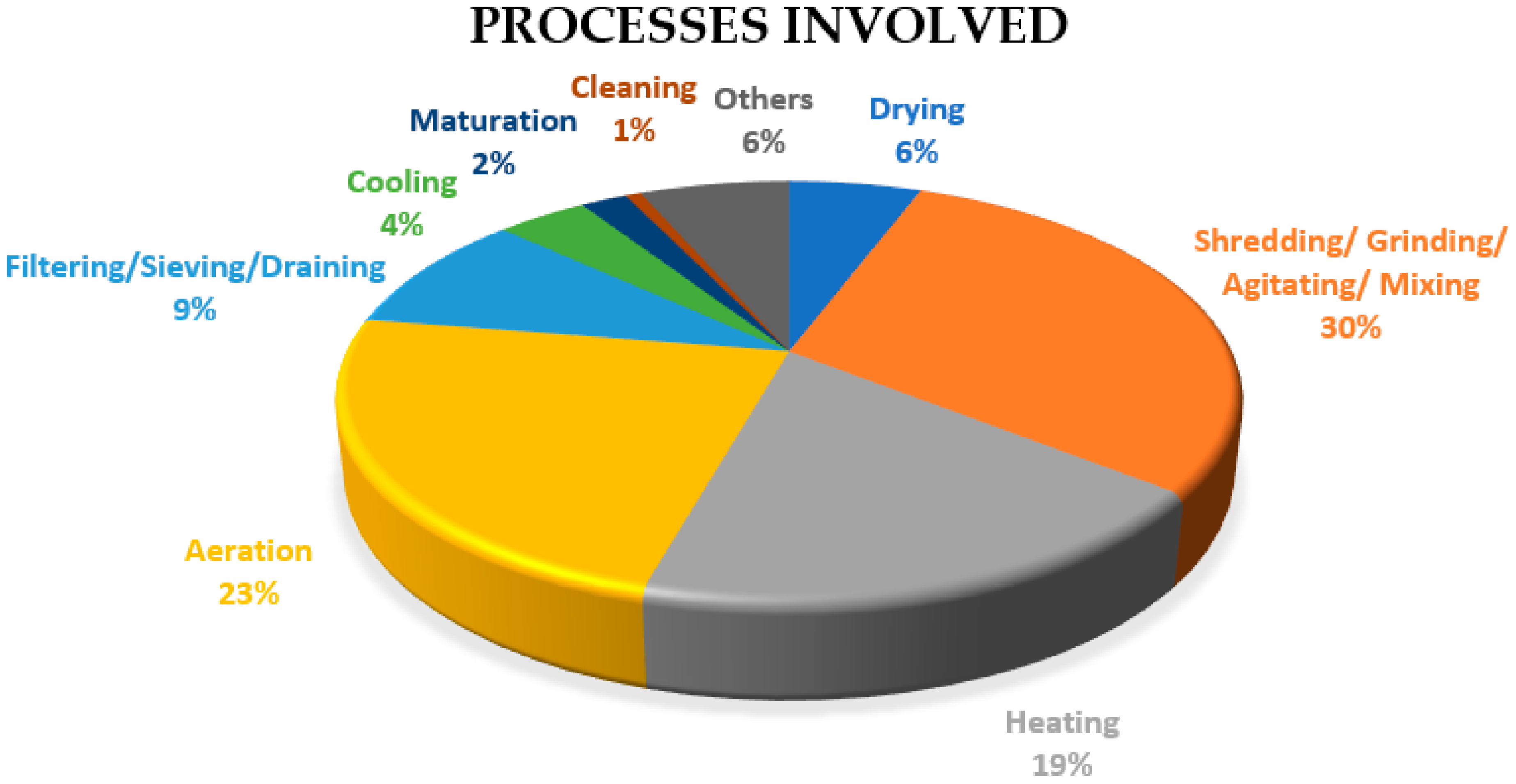
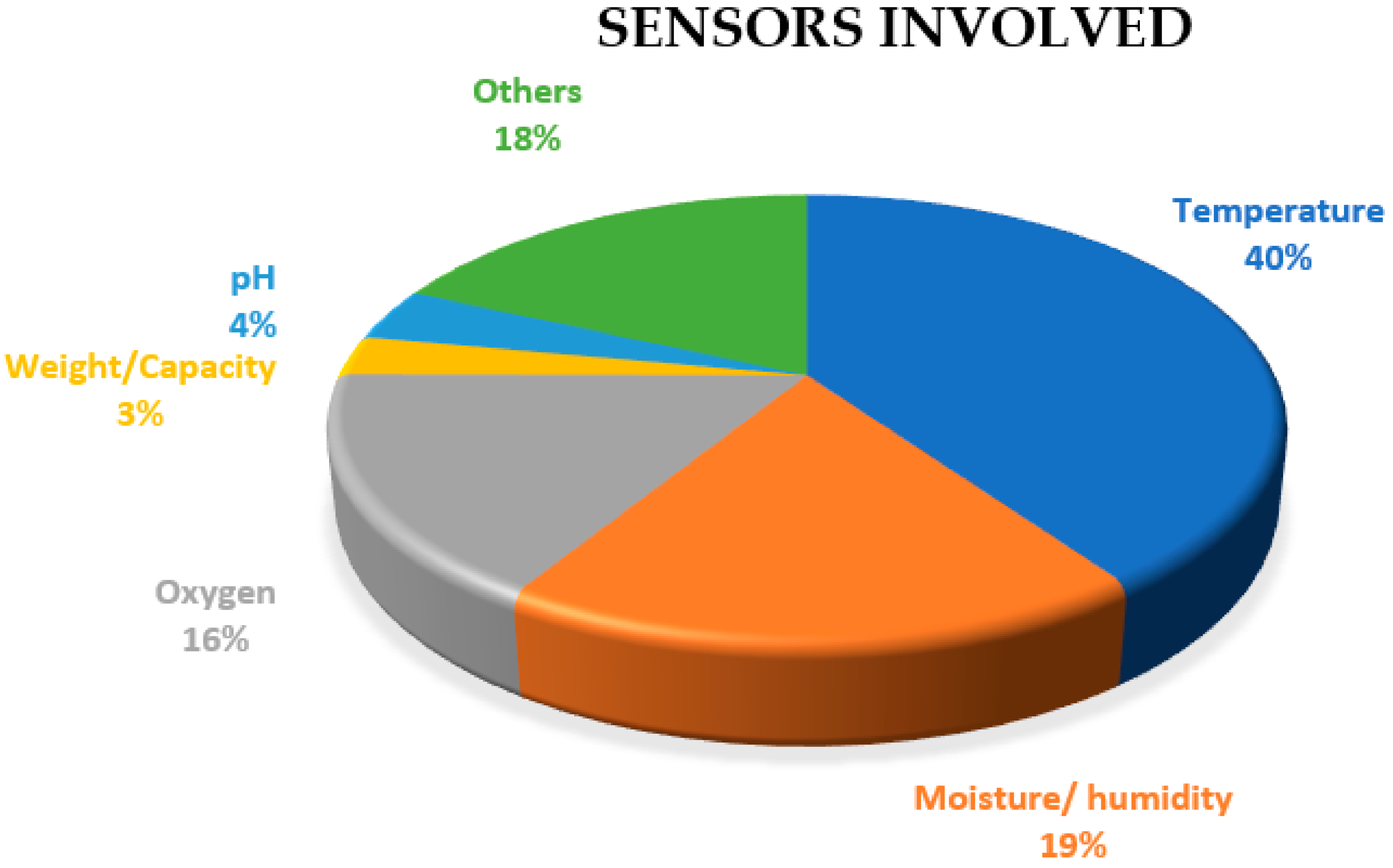
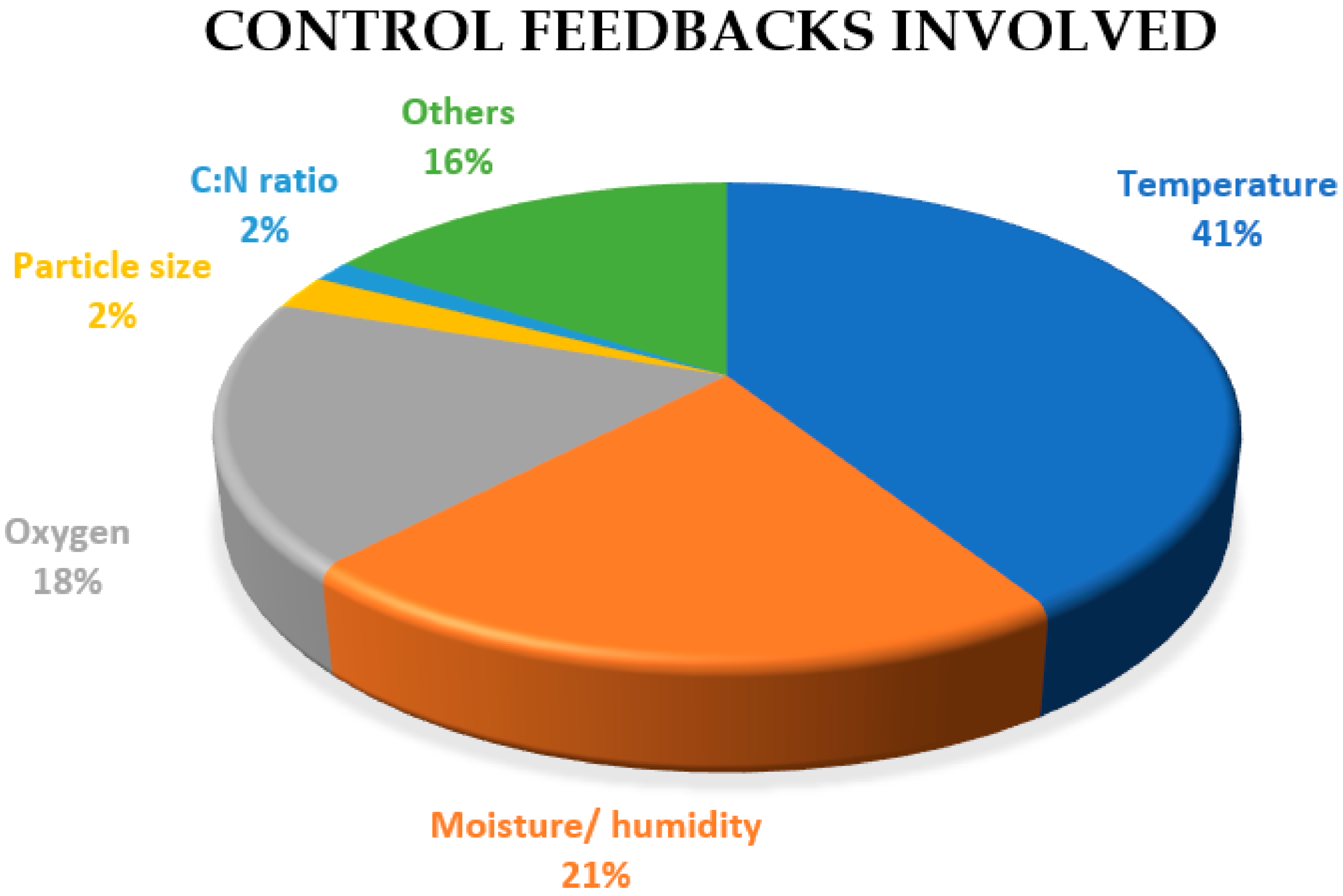

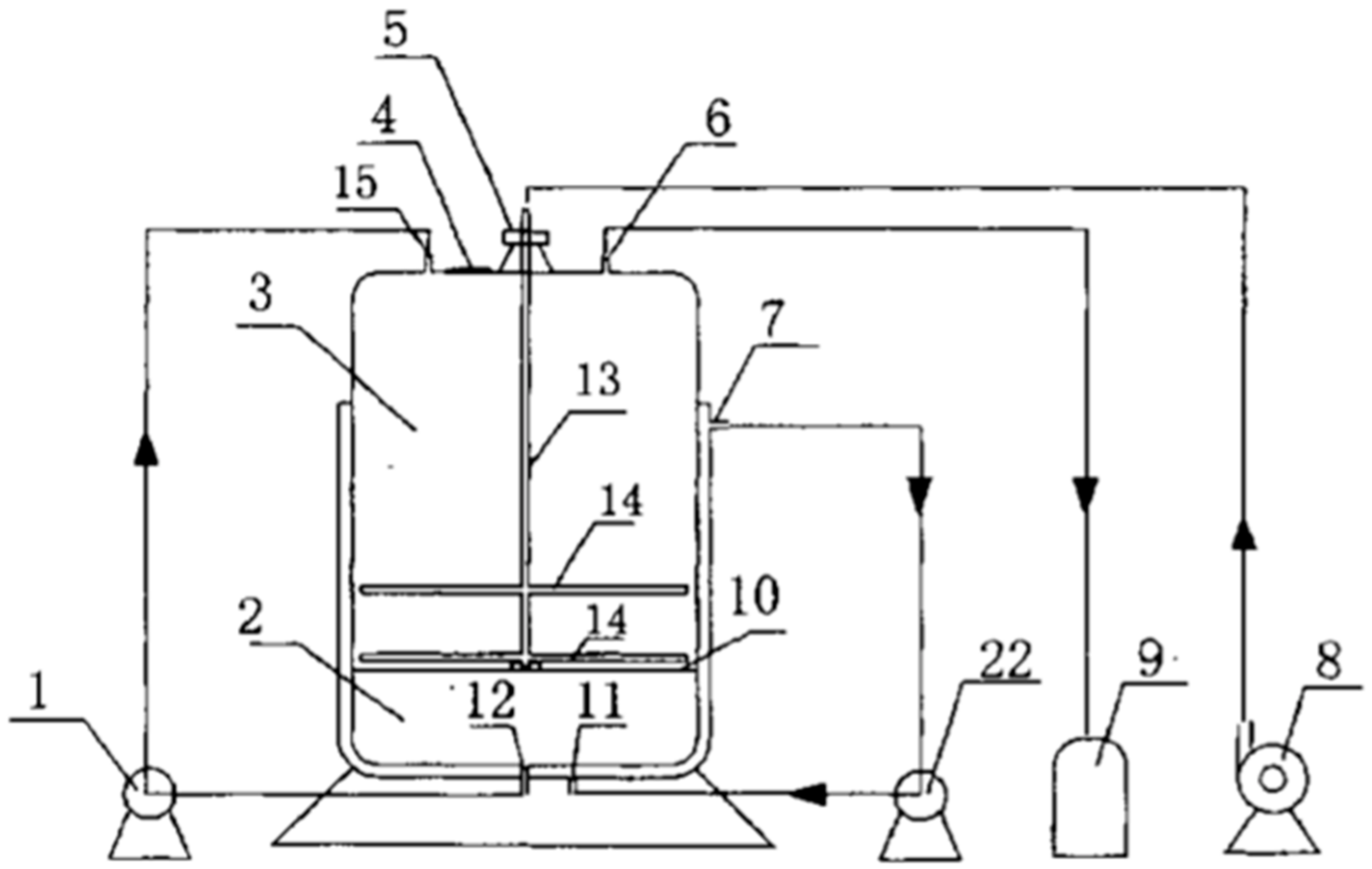

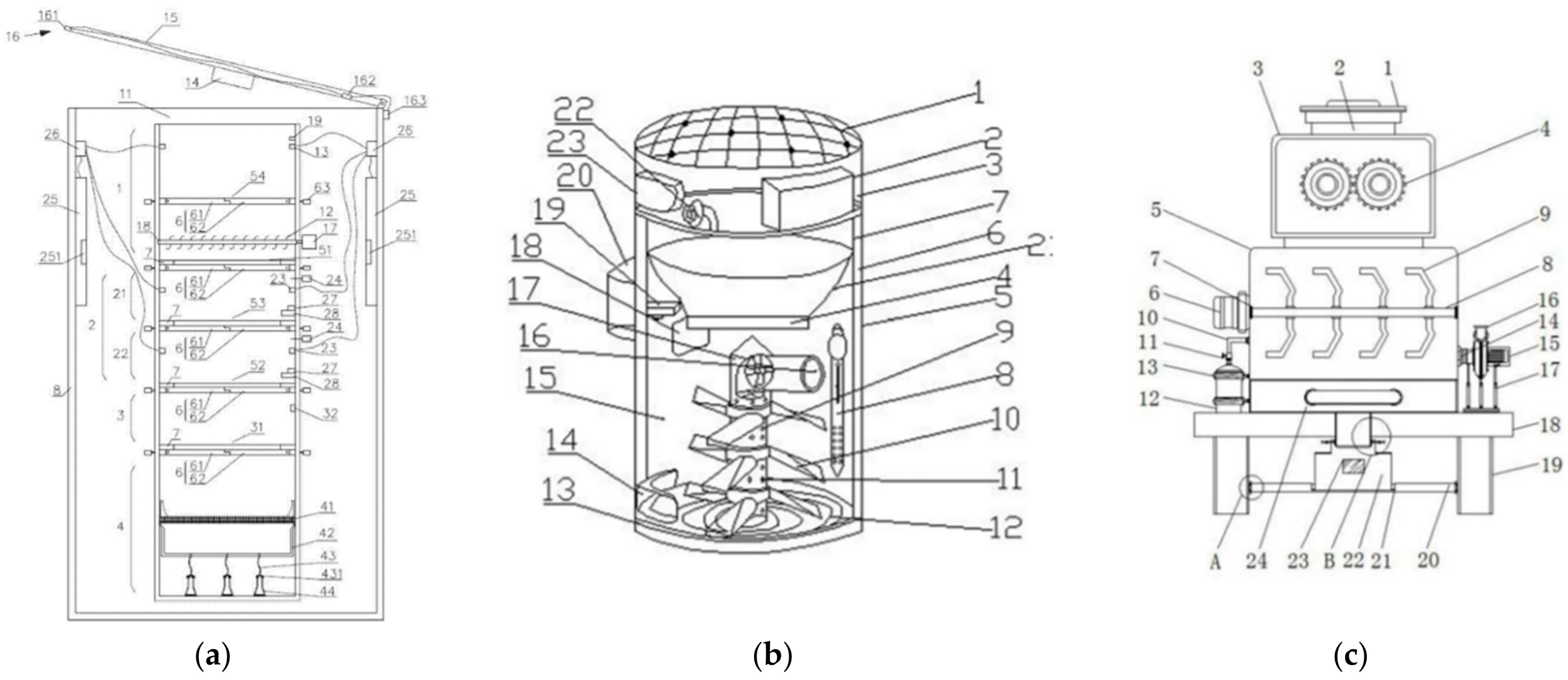
| Variable | Ideal Range |
|---|---|
| Moisture | 45–60% by weight |
| Oxygen concentration | >5% |
| Temperature | 40–65 °C for thermophilic phase |
| C:N ratio | 25:1–30:1 |
| Porosity | 35–50% |
| pH | 5.5–8.0 |
| Phase Cycle | Process |
|---|---|
| Drying | Food recyclers attain an interior temperature of roughly 70 °C during the first drying phase to reflect the naturally occurring and ideal heat of a compost heap. The heat and aeration are evenly dispersed by the unit’s grinding gears, which gently turn so that every surface area is disinfected and methane-free. Air is pumped through carbon filters and discharged out the back of the machine to supply air. The drying process reduces the volume of the initial organic materials. |
| Grinding | The unit’s internal grinding gears then turn the contents once the food waste has been reduced in size. This further breaks down the food waste into minute, powder-like particles that may be easily mixed in with soil. |
| Cooling | This phase brings the unit and the contents of the bucket back to room temperature, allowing for safe handling. This phase also continues the previous phases’ aeration and dehumidification. |
| Curing | Continuous aeration and moisture are regulated where the contents are allowed to stabilize for weeks. The curing phase cycle often takes longer than other phase cycles. |
| Product Name | Product Image | Features | Price in USD | References |
|---|---|---|---|---|
| Vitamix FoodCycler FC-50 | 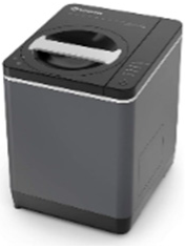 | Size: 12.6” × 11” × 14.2” Weight: 27 lbs Capacity: 2.5-L bucket Power consumption: 0.8 kWh/cycle Processing time: dehydrated, ground, and cooled material in 4–8 h. Phase cycle: drying, grinding, and cooling only | $400 | [69] |
| BeyondGREEN Composter |  | Size: 20” × 12” 20” Weight: 22 lbs Capacity: 5 lbs per day Processing time: Compostable material in 5 days and high-nitrogen compost in 2 weeks. Phase cycle: drying, grinding, cooling, and curing | $380 | [70] |
| Oklin GG-02 Composter |  | Size: 30” × 18” × 18” Weight: 60 lbs Capacity: 8 lbs Power consumption: 60–90 kWh/month Processing time: usable soil amendment in 24 h. Phase cycle: drying, grinding, and cooling | $1200 | [71] |
| Lomi Composter |  | Size: 16” × 12” × 13” Capacity: 7 lbs Power consumption: 1 kW/h Processing time: dry material in 20 h Phase cycle: drying, grinding, and cooling only | $499 | [72] |
| KALEA Composter | 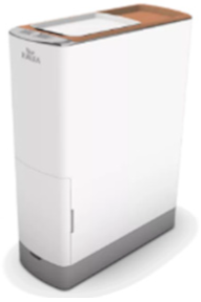 | Size: 9” × 25” × 20” Capacity: 7 lbs Power consumption: 200 kW/year Processing time: 48 h into nourishing compost Phase cycle: drying, grinding, cooling, and curing | $800 | [73] |
| NatureMill ULTRA Composter | 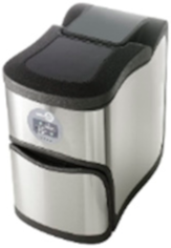 | Size: 20.3” × 20” × 12.6” Weight: 25.4 lbs Capacity: 120 lbs/month Power consumption: 5 kWh/month Processing time: compost in 2 weeks Phase cycle: drying, grinding, cooling, and curing | $500 | [74] |
| Manual composting | |||||
| Method of composting | Cost | Maintenance | Space requirement | Composting duration | Labor requirement |
| Windrow | Very low | Very low | Very high | Moderate | Very high |
| Passively Aerated Windrow | Low | Low | Very high | Moderate | Low |
| In-Vessel | Very high | Very high | Moderate | Fast | Low |
| Bin | Moderate | Low | Moderate | Slow | Low |
| Vermicomposting | Very low | Low | Low | Fast | Very low |
| Automatic composting | |||||
| Method of composting | Cost | Maintenance | Space requirement | Composting duration | Labor requirement |
| Forced Aerated Windrow | High | High | High | Fast | Low |
| Automatic Turning In-Vessel | Very high | Very high | Moderate | Fast | Very low |
| Electric | High | High | Low | Very fast | Very low |
| Category | Keyword |
|---|---|
| Technology | Search (Automatic composter or Composting Device or Waste Composter or Food Recycler or Compost Heater) (Title, Abstract, Claims) |
| Process | Search (Compost Collecting or Compost Heating or Aerobic Composting or Mixing Compost or Food Recycling or Organic Waste Treatment) (Title, Abstract, Claims) |
| IPC Group | Search (C05F or C12M or B02C or B07B or B65F or A23L) |
| IPC Code | Description |
|---|---|
| A23L | Foods, foodstuffs, or non-alcoholic beverages, their preparation or treatment; preservation of foods or foodstuffs, in general |
| B02C | Crushing, pulverizing, or disintegrating in general; milling grain |
| B07B | Separating solids from solids by sieving, screening, sifting, or by using gas currents; separating by other dry methods applicable to bulk material |
| B65F | Gathering or removal of domestic or like refuse |
| C05F | Organic fertilizers, e.g., fertilizers from waste or refuse |
| C12M | Apparatus for enzymology or microbiology |
| Category Type | Description | Category | Composition of Each Category |
|---|---|---|---|
| Technology | Composting technology is exclusive where it can be either manual, partially automatic, or fully automatic | Manual | 22.76% |
| Partially automatic | 17.29% | ||
| Fully automatic | 59.96% | ||
| Composting process | Composting type is non-exclusive, where a patent may fit into multiple categories: aerobic, anaerobic, or undetermined. Undetermined refers to an unspecified type of composting in a particular patent | Aerobic | 86.50% |
| Anaerobic | 5.49% | ||
| Undetermined | 8.02% | ||
| System size | System size is exclusive where it can be either small- or large-sized | Small-sized | 26.91% |
| Large-sized | 73.09% | ||
| Waste type | Waste type is unexclusive where it can be at least one from the garden, agricultural, animal manure, food/kitchen, and general organic wastes (which can consist of the previously mentioned type of wastes) | Garden waste | 4.90% |
| Agricultural waste | 4.05% | ||
| Animal manure | 5.97% | ||
| Food/kitchen waste | 26.87% | ||
| General organic waste | 58.21% |
| IPC Code | Details |
|---|---|
| A23 | Foods or foodstuffs; treatment thereof, not covered by other classes |
| B01 | Physical or chemical processes or apparatus in general |
| B02 | Crushing, pulverizing, or disintegrating; preparatory treatment of grain for milling |
| B09 | Disposal of solid waste; reclamation of contaminated soil |
| B65 | Conveying; packing; storing; handling thin or filamentary material |
| C02 | Treatment of water, waste water, sewage, or sludge |
| C05 | Fertilizers; manufacture thereof |
| C12 | Biochemistry; beer; spirits; wine; vinegar; microbiology; enzymology; mutation or genetic engineering |
| F23 | Combustion apparatus; combustion processes |
| F26 | Drying |
| Composting Type | Patent Number | Patent Title | Inventors |
|---|---|---|---|
| Aerobic | CA2328680C | Composting Device | Morrison Michael Joseph. |
| CA2671248C | Composter | Stanford Carl R., Ashby Kent. | |
| CN103449849B | A kitchen waste compost device and composting method | Qu Xiao-lin, Wang Xue-jiao, Zhao Xue-fei. | |
| CN206872695U | A kitchen garbage composting device | Li Jing, Zhang Tian-zhu, Wang Shun-sheng, Guo Jing-jing, Wang Shuai, Guo Dun, Liu Jin-cheng. | |
| CN210163350U | Compost fermentation barrel | Chen Shi-Jiang. | |
| CN212051158U | Rotary drum-type composting device | Yuan Yu-Zhe. | |
| CN213977467U | Horizontal composting device | Guo Cong-jun, Meng Ying. | |
| Anaerobic | CA2319808C | Improvement in composting toilet | Lejgren Harry. |
| Undetermined (Both Aerobic and Anaerobic) | CN204824645U | An organic garbage alternate aerobic and anaerobic composting | Zhou Shao-qi, YuanJin-peng, Yang Zhi-quan |
| CN1206189C | Anaerobic and aerobic integrative type compost response operator | Qiao Wei, Zeng Guang-ming, Huang Guo-he, Yuan Xing-Zhong |
| Composting Type | Patent Number | Patent Title | Inventors |
|---|---|---|---|
| Aerobic | CA2436322C | Rotatable Aerating Composter | Windle Harry Neal |
| CN108383556A | A fast, harmless organic waste processing method and system | Huang Bing-Feng | |
| KR2019021983A | Food Compost | Moon Jo Young | |
| US20120021504A1 | Aerated Composter and Waste Collection Bin | Bradlee Michael | |
| CN101983951B | Composting device for domestic waste | Li Bing, Dong Zhi-Ying, Chen Yu-hui, Zhu Jianlin, Cai Zhao-qi | |
| CN107021795A | A kitchen garbage composting device for family and composting treatment method | Xu Wei-ping, Deng Ying, Xu Jian-qiang | |
| CN205088151U | Aerobic composting device | Guo Chun-yu, Suo Ya-li, Wang Wei-dong | |
| Anaerobic | AU2021204513A1 | Apparatus, Methods, and Systems for Food Waste Recycling | Boyle Norman |
| CN112354616A | Food waste treatment device capable of recycling resources | Chen Ben-Zhong, Zhao De-long | |
| Both Aerobic and Anaerobic | CN1248792C | Organic waste material treatment process | Rudas T |
| Composting Type | Patent Number | Patent Title | Inventors |
|---|---|---|---|
| Aerobic | CN112960996A | Composting device based on a spiral stirring structure | Sun Guo-tao, Wang Xiu-zhang, Liu Xiao, Shao Zhi-Jiang |
| CN208649153U | A household kitchen waste composter | Wu Han-zhang, Shen Kai-bin | |
| CN209555095U | An outdoor kitchen waste compost fermentation barrel | Liu Yu-ting, Zeng Xiang-lai, Xian Yi-nan, Chen Lai-yi | |
| IN201841044613A | A device for converting organic waste into organic compost | Giridhara Baluvaneralu Venkatakrishnaiah, Thazhe Vilippavil Muhammed Sameer | |
| CN111187101A | Household kitchen waste treatment device | Wang Mei-yin, Yang De-ming, Zhou Ting-jin, Meng Han-yu, Zhang Min-ling, Zhu Liang | |
| US8129177B2 | Automatic self-contained compost device | Cohn Russell S. | |
| US6284528B1 | Small scale automated composter | Wright James | |
| Anaerobic | EP2980203A1 | Anaerobic digester for the treatment of organic waste | Arribas De Paz Ricardo |
| Both Aerobic and Anaerobic | CN212954904U | A new type of household garbage composting device with deodorizing function | Wang Yi-da |
| CN208346058U | Organic garbage aerobic and anaerobic composting device | Zhang Xiao-hong |
Publisher’s Note: MDPI stays neutral with regard to jurisdictional claims in published maps and institutional affiliations. |
© 2022 by the authors. Licensee MDPI, Basel, Switzerland. This article is an open access article distributed under the terms and conditions of the Creative Commons Attribution (CC BY) license (https://creativecommons.org/licenses/by/4.0/).
Share and Cite
Azis, F.A.; Rijal, M.; Suhaimi, H.; Abas, P.E. Patent Landscape of Composting Technology: A Review. Inventions 2022, 7, 38. https://doi.org/10.3390/inventions7020038
Azis FA, Rijal M, Suhaimi H, Abas PE. Patent Landscape of Composting Technology: A Review. Inventions. 2022; 7(2):38. https://doi.org/10.3390/inventions7020038
Chicago/Turabian StyleAzis, Fatin Amanina, Masrur Rijal, Hazwani Suhaimi, and Pg Emeroylariffion Abas. 2022. "Patent Landscape of Composting Technology: A Review" Inventions 7, no. 2: 38. https://doi.org/10.3390/inventions7020038







